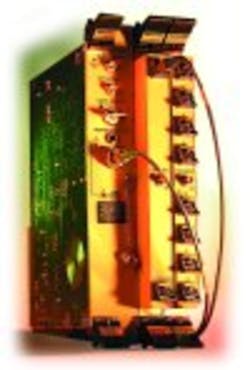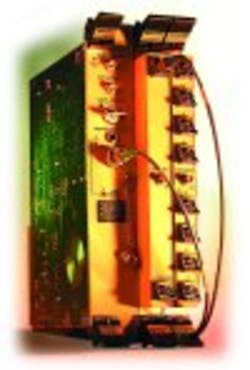To meet technological demands of today and tomorrow, designers and manufacturers of advanced optical components need test equipment that offers higher measurement speed, accuracy, and resolution than available from conventional test solutions. As vendors develop higher speed dense wavelength division multiplexing (DWDM) communications systems, optical components increase in channel count and have narrower bandwidths and tighter tolerances.
Concurrently, component manufacturers are under pressure to lower manufacturing costs. This requires an increase in test throughput and yield.
Optical Components and Measurement Needs
In DWDM transmission systems deployed in the early 1990s, two to eight wavelengths traveled along the fiber spaced about 400 GHz apart. Thanks to dramatic technological advancements, today’s DWDM systems have up to 160 channels spaced at 50 GHz. To increase the transmission capacity of optical fiber, communications system vendors are working on solutions to transmit even more channels spaced at 25 GHz or even 12.5 GHz.
These technological trends place high demands on the optical components used to combine, separate, and otherwise control the different wavelengths. Demultiplexers, for example, separate the wavelengths at the receiving end of a transmission link. To facilitate higher channel counts, optical filters need narrower bandwidths.
The performance of optical components is defined by their insertion loss and return loss as a function of wavelength. These parameters also depend on the polarization of the incoming light and the temperature of the operating environment. For multiport devices, the loss characteristics must be determined for every combination of input and output ports.
As component technology advances, so do the requirements for test equipment. Component designers and manufacturers not only have to cope with higher channel counts and narrower channel spacing, but also with the pressure for cost reduction and increased production volume. As a result, test time and accuracy are major considerations. Accordingly, faster and more efficient test equipment is needed to determine the performance characteristics with higher accuracy, repeatability, and resolution.
Conventional Measurement Solutions
An early method of characterizing optical components used a broadband light source and an optical spectrum analyzer (OSA). It is simple and fast, but the wavelength resolution and accuracy of OSAs are limiting. At best, an OSA provides wavelength uncertainty and resolution of 10 pm. This is suitable for optical components for a channel spacing of 100 GHz but not for advanced components with denser spacing of 50 GHz, 25 GHz, and less. Also, an OSA is limited to measuring a single port at a time.
To achieve finer resolution and higher channel counts, a newer approach replaces the broadband light source with a swept tunable laser and the OSA with fast, multichannel optical power meters. In a test, the laser sweeps over the wavelength span of interest while the power meters record the insertion loss of the device. A computer combines the wavelength settings of the laser with the power-meter readings to obtain the transmission characteristics of the device as a function of wavelength.
These so-called swept wavelength systems use the narrow bandwidths of tunable lasers, which enable measurement resolutions of 1 pm and better. If tunable lasers with high output power and low spontaneous emissions are used, these systems surpass OSAs in dynamic range.
On the downside, the wavelength accuracy of generic swept wavelength systems is limited to the wavelength setting accuracy of the tunable lasers. Commonly, external-cavity lasers find applications in swept systems since they offer a wide tuning range and sufficient spectral purity.
However, these lasers select the wavelength via a rotating grating, which is the same method used inside OSAs. For that reason, it comes as no surprise that the wavelength accuracy of basic swept systems does not exceed that of OSAs.
To achieve the wavelength accuracy required for characterizing advanced optical components, swept systems can be combined with wavelength meters. Based on an interferometric principle and a built-in, stable wavelength reference source, they can measure the laser wavelength with uncertainties of 1 pm and better (Figure 1).
Because they involve moving mechanical parts, swept wavelength systems are limited to a few measurements per second. To assure the accuracy of every measurement point, the wavelength must be measured at every increment. Accordingly, the laser must keep pace by slowing down or even stepping from point to point, dramatically increasing the measurement time for a wavelength scan. At a typical measurement time of 100 ms/point, characterizing a component over a wavelength band of 25 nm with a resolution of 1 pm takes more than 40 minutes.
One solution to improve the measurement time, while still achieving some of the desired wavelength accuracy, calibrates the laser at every wavelength point only in certain time intervals, but not for every sweep. This method improves throughput for the individual measurement cycles but still requires a time-consuming calibration sweep.
This method also is subject to drifts in laser wavelength between the calibration cycles, which can easily increase errors to unacceptable levels. An alternative calibrates the wavelength only at certain wavelength points but during every sweep. While this improves the accuracy compared to a sweep without any calibration, it still ignores the fact that tunable lasers have nonlinear characteristics that lead to wavelength errors between the calibration points. Traditional optical test methodologies offer the resolution needed for testing advanced components, but they only can provide fast testing or accurate testing—not both.
A New Approach
A system with a swept wavelength meter (SWM) that determines the wavelength at every measurement point with traceable calibration but without the need to slow down the laser sweep can test advanced optical components. The remaining elements of the system architecture are identical to those of conventional swept wavelength systems. A swept external-cavity laser scans the wavelength range of interest, and multiple optical power meters sample the light output from the device under test at a high measurement rate (Figure 2).
Like conventional wavelength meters, the SWM has an interferometer and a stable wavelength reference. Instead of a dynamic Michelson interferometer with moving mirrors, it has a static, fiber-based Mach-Zehnder interferometer, and in place of a Helium-Neon laser, it uses a NIST-traceable gas-absorption cell.
Key to the operation of the SWM is the synchronous acquisition of time-series data from the sensors inside the SWM and the power meters of the swept wavelength system. The measurements of all sensors are triggered by the laser sweep.
As shown in Figure 3, the SWM has built-in power sensors at the output of the Mach-Zehnder interferometer and the gas-absorption cell. While the laser sweeps, all of the sensors acquire data in parallel and collect the time-series data in local memory of the SWM and in the power meters. At the end of the sweep, all data is transmitted to the system CPU over a high-speed PCI data bus for further processing.
The Mach-Zehnder interferometer in the SWM is made up of optical fiber with two paths of different lengths. While a conventional Michelson interferometer produces an interferogram through mechanical changes of the path lengths, the static Mach-Zehnder interferometer generates an interferometric output signal as the wavelength of the tunable laser changes during a sweep.
The signal intensity is a sine-squared function of the wave number of the laser signal. The inverse sine-squared function of this yields the phase number of the interferogram that is a function of the wave number at every measurement point of the laser sweep. Dispersion in the fiber causes small deviations from the ideal sine-squared function, but these are deterministic and can be easily corrected numerically.
The gas-absorption cell is used as a wavelength reference to determine the exact wavelength of the sample points. The absorption wavelengths are highly stable and traceable to NIST standards.
Swept Wavelength SystemsThe OTS9600 Series uses the company’s patent-pending wavelength reference technology. The system automatically calibrates prior to each measurement, eliminating the need for manual calibration and reducing test time.
Also available is a new set of tunable lasers, stimuli needed for many different optical testing applications. The lasers are mode-hop free and offer a fast tuning speed. The series also includes an eight-channel power meter. Both the lasers and the power meter modules can be used in stand-alone applications.
The spectrum of the absorption cell is measured synchronously at exactly the same time instances as the output of the Mach-Zehnder interferometer. As a result, the absorption peaks correlate with the sine-squared function from the interferometer and can be used to calculate the linear coefficients that equate the phase of the interferometer with the wave number of the laser. A least-square fit to the wave number-phase data then yields the absolute wavelength at every sample point. Since the insertion loss of the device under test is measured synchronously with the signals from the absorption cell and interferometer, this method delivers the accurate wavelengths of the insertion loss measurement.
Reference
Anderson, Duwayne, “Real-time Wavelength Calibration with Picometer Accuracy in Swept-Laser System,” Proceedings of NFOEC 2001, p. 1089.
About the Author
Mark Albert is a product marketing manager for optical test equipment at Tektronix. He has been with the company for more than five years and published several technical articles about optical communication test issues. Mr. Albert holds an M.S.E.E. from the Technical University of Darmstadt, Germany, and an M.B.A. from the University of North Carolina. Tektronix, P.O. Box 500, MS 50-321, Beaverton, OR 97077, 503-627-4574, e-mail: [email protected]
For More Information
Passive Optical Component Test Application Note
www.rsleads.com/209ee-215
Return to EE Home Page
Published by EE-Evaluation Engineering
All contents © 2002 Nelson Publishing Inc.
No reprint, distribution, or reuse in any medium is permitted
without the express written consent of the publisher.
September 2002

